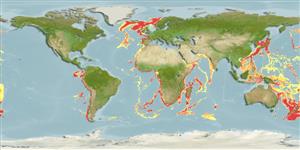Elasmobranquios (tiburones y rayas) (sharks and rays) >
Squaliformes (Sleeper and dogfish sharks) >
Centrophoridae (Gulper sharks)
Etymology: Centrophorus: centr[um] (L.), prickle or sharp point; phorus, from phoreus (Gr.), bearer or carrier, referring to grooved spines on dorsal fins. (See ETYFish); squamosus: squama (L.), scale; -osus, Latin suffix connoting fullness, i.e., scaly, referring to its large scales. (See ETYFish).
More on author: Bonnaterre.
Environment: milieu / climate zone / depth range / distribution range
Ecología
marino batidemersal; rango de profundidad 145 - 2400 m (Ref. 6871). Deep-water; 69°N - 54°S, 92°W - 176°W
Atlantic, Indian, west and southeast Pacific Oceans.
Length at first maturity / Tamaño / Peso / Age
Maturity: Lm 126.1, range 110 - 158 cm
Max length : 164 cm TL macho / no sexado; (Ref. 58048)
Espinas dorsales (total): 2; Radios blandos dorsales (total): 0; Espinas anales 0; Radios blandos anales: 0. A large gulper shark with a short, broad snout, a long, low 1st dorsal fin, short pectoral rear tips, and large, rough, leaf-like denticles (Ref. 5578). Dark grey or chocolate brown in color (Ref. 5578).
Found on or near the bottom of continental slopes; also found pelagically in the upper 1,250 m of water 4,000 m deep (Ref. 31367). Presumably feeds on fish and cephalopods (Ref. 6871). Ovoviviparous (Ref. 50449). Utilized and fishmeal and dried salted for human consumption (Ref. 247); meat and fins (low value) and liver oil (very high value), and occasionally for its mature eggs (Ref.58048).
Ovoviviparous, embryos feed solely on yolk (Ref. 50449). Young numbers 5-8 in a litter (Ref. 6871). Size at birth 35-43 cm (Ref. 26346). Distinct pairing with embrace (Ref. 205).
Compagno, L.J.V., 1984. FAO Species Catalogue. Vol. 4. Sharks of the world. An annotated and illustrated catalogue of shark species known to date. Part 1 - Hexanchiformes to Lamniformes. FAO Fish. Synop. 125(4/1):1-249. Rome, FAO. (Ref. 247)
IUCN Red List Status (Ref. 130435)
Threat to humans
Harmless
Human uses
Warning: mysqli::__construct(): (HY000/1040): Too many connections in /var/www/html/includes/func_getlabel.php on line 46
Can't connect to MySQL database (fbapp). Errorcode: Too many connections
